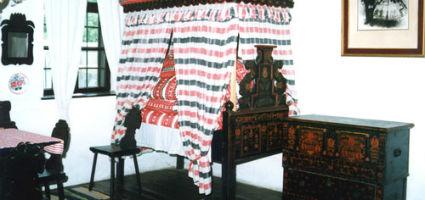2024. April 20. Saturday
Sárköz Region House - Decs
 |
Address: 7144, Decs Kossuth Lajos utca 34-36.
Phone number: (74) 495-069
Opening hours: 01.IV-31.10.: Tue-Sat 9-12, 13-18
01.11-31.03.: Tue-Sat 10-12, 14-16 |
The collection of the Popular Arts Region House was established in 1955. Its building, a well-off peasant house was erected in 1863. It has mud walls, an open-chimney kitchen and a neat column-held veranda. In the first three rooms there are the so-called clean room, kitchen and living room. The enteriour originates from the 19th century. Embroideries, popular fabrics and clothes are also exhibited.
The region house is white washed. At the time it was built land owners of the region hired masons from Bátaszék, Tolna and Dunakömlőd to build 4-5 roomed brick houses.
The rooms were first furnished with painted furniture, then object of aristoctűratic taste were added. The painted and tuliped boxes were made in Komárom. The beds, bowls and benches were produced in Harta and Baja. The glass jars and ornamented ceramics were made in Mórágy, Szekszárd and Baja.
Visitors can learn about the local way of dressing. The pompous dresses, pearls and other ornaments of the women were brought from Lyon, Vienna and Pest. When the girls got married, they were given expensive dresses - or inherited them from relatives.
In the 1880'ies women used to cover their hair with a special kind of cordiroy veil.
The skirts, norrow aprons and special shoulder scalrs were made of the most expensive materials.
Sárköz was famous for its various kinds of embroideries. They used special tulips, pomagranates and other flower motives even in their funeral ceremonies.
Until the end of the 1880'ies the bride had used to give the bridegroom a piece of shawl woven and embroidered by herself.
The region house is white washed. At the time it was built land owners of the region hired masons from Bátaszék, Tolna and Dunakömlőd to build 4-5 roomed brick houses.
The rooms were first furnished with painted furniture, then object of aristoctűratic taste were added. The painted and tuliped boxes were made in Komárom. The beds, bowls and benches were produced in Harta and Baja. The glass jars and ornamented ceramics were made in Mórágy, Szekszárd and Baja.
Visitors can learn about the local way of dressing. The pompous dresses, pearls and other ornaments of the women were brought from Lyon, Vienna and Pest. When the girls got married, they were given expensive dresses - or inherited them from relatives.
In the 1880'ies women used to cover their hair with a special kind of cordiroy veil.
The skirts, norrow aprons and special shoulder scalrs were made of the most expensive materials.
Sárköz was famous for its various kinds of embroideries. They used special tulips, pomagranates and other flower motives even in their funeral ceremonies.
Until the end of the 1880'ies the bride had used to give the bridegroom a piece of shawl woven and embroidered by herself.
|
Programmes
|
|
|
Permanent exhibitions
|
|